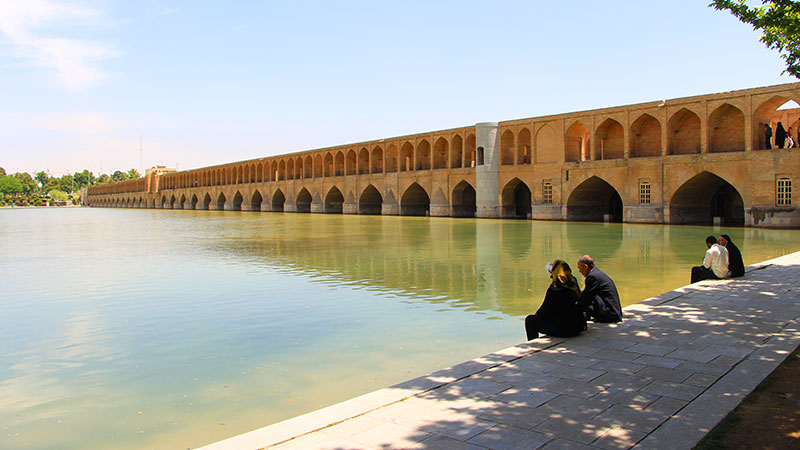 Signin with Google
Signin with Google Signin with Facebook
Signin with Facebook Places
PlacesSi O Se Pol, a Bridge and Thirty Three Sights

The beauty of Isfahan owes much to the life-giving river, "Zayandeh Roud" which is the largest river of the Iranian plateau snaking through the city from south to southwest. Since the Sassanian era (224-651 AD), eleven bridges have been built over this unnavigable river. It is the story of the largest historical bridge on the Zayande River that carries dreams besides people's bodies and minds and leads hearts to meet each other along its 33 vaulted arches.
The bridge of 33 arches
"Si o Se Pol" with a history of about four centuries is an iconic symbol of Esfahan, half of the world. Its popular name comes from the number of arches that has been placed in two rows on the bridge that is thirty-three. Si o Se Pol also serves as a dam and a gathering place that connects the central core of the Safavids' capital to the Armenian quarter of New Jolfa.

A rhythmic structure expanding over the river
After moving the capital from Qazvin to Esfahan, Shah Abbas, the great Safavid king, ordered building a bridge and dam across the Zayandeh Rood River in the early 17th century. Over the widest but shallowest part of the river, this beautiful stone bridge was erected to present one of the most famous examples of Iran's Safavid architecture.
While the central lane of the upper level of the bridge was a wide path for carriages, the sides were used as pedestrian promenades. People could rest in the shade of the arched walkways and enjoy the scenic view of the river.
Allahverdi Khan's legacy
Si-o-Se Pol is also known as Allahverdi Khan Bridge. The construction process was completed under the direct supervision of Allahverdi Khan, the distinguished Georgian commander and chancellor of Shah Abbas of Safavi.
Adam Olearius, the German author and scholar who travelled to Iran in 1635 as a diplomat described Si o Se Pol in his book: "Allahverdi khan sometime governor of Shiraz built at his Zayandeh River, which is as broad as the Thames is at London."

The arena of public promenades
Connecting Jolfa, the Armenian neighbourhood and Chahar Bagh, the royal mansions to the rest of the city, Si-o-Se Pol became the heart of Isfahan. It was an arena for pleasure walks, cultural events and rituals during the Safavid time.
The big celebration usually took place on Nowruz, Persian New Year. At the beginning of summer, people gathered on the banks of the Zayandeh River to hold an ancient Zoroastrian festival, Ab-Pashonak. To worship "Anahita", the Goddess of water, they sprinkled water on each other believing that it would bring light and blessings to their lives.
Or on January 6, Christians living in Isfahan used to get together near the river for the Khaj Shooyan celebration. On this exact day, they wash in Zayandeh Roud to celebrate the baptism of Christ.
Today these ceremonies are not being held anymore, but Si-o-Se Pol and Zayandeh Roud banks are still gathering spots to relax and recreate. After the sunset, just when the lightings magnify the arches of the bridge, it is the best time to be in Si-o-Se Pol. Take a walk in the riverside park or enjoy a pleasant stroll over the river and sit in a vaulted arch to relax.

A gem in the ring of the city attractions
From Si-o-Se Pol, other Esfahan tourist attractions are close by. Walking a few minutes along the Zayandeh River, another magnificent bridge, Khaju Bridge stands. Naqsh-e Jahan Square, the UNESCO- listed world heritage site, locates in less than 20 minutes and Vank Cathedral or Hasht Behesht Palace are also a few minutes far from Si-o-se-pol.
Sir Percy Sykes, the English diplomat, traveller, and writer who was impressed by Si-o-Se Pol, says "even in decay must rank among the great bridges of the world". This beautiful bridge, with its culminating architecture, is an excellent part of Iranian history and visitors' memory.

By Samaneh Zohrabi / TasteIran


